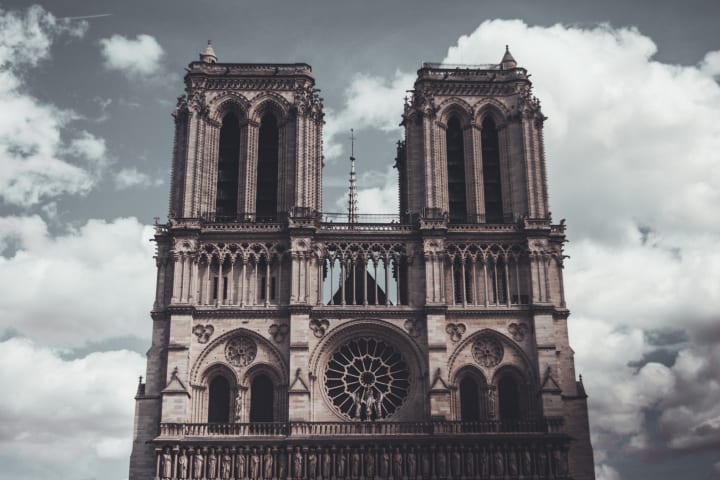The False Paradox: Cultural Heritage vs Human Life
The Underlying Problems of Society Exposed by the Burning of Notre Dame

As I sat on the train on my commute home on Monday April 16, I, like millions of others, read the news in horror.
Notre Dame was burning.
My heart hurt as it felt like I had seen this scene play out all too often in the past few years. From the burning of the National Museum of Brazil in 2018 to the destruction of Palmyra in Syria, it seems like the world is losing its cultural heritage at a rapid rate. As the dust settled the next day and the damage was accessed, there was a bitter sweet relief as it was announced that the spire, which had collapsed, would be rebuilt. In less than 24 hours over 600 million in donations were pledged to rebuild Notre Dame. This should be good news, worth rejoicing about. Yet, there is this nagging thought that just won’t go away…
If we can raise over 6 million in funds to re-build Notre Dame, why are other causes, which directly affect the well-being of human lives, struggling to obtain donations?
Now don’t get me wrong, Notre Dame is an important cultural landmark that deserves to be preserved. But what makes it more worthy of saving than other landmarks that have been destroyed, such as the three historically black churches that were burnt down as a hate crime in Louisiana? Why can we raise this much money for a building, but we the people of Puerto Rico are still struggling to rebuild after Hurricane Maria in 2017? Why do tragedies that occur in historically imperial countries get more media attention than that of countries that have historically been colonized? Does society value the existence of historic landmarks more than a human life?

Photo by Priscilla Fraire on Unsplash
A Single Tragedy Verses Large Scale Destruction
It can be claimed that it is easier to connect with a single event where the tragedy affects only one person or artifact because it becomes too overwhelming to process destruction on a larger scale. When several thousand people die it can be hard to comprehend and tragedy becomes a statistic rather than an event that evokes an emotional response that calls people to action. It is easier to emotionally connect when there is one defined victim forces can rally behind, especially when there is a defined solution to a problem.
Notre Dame, for example, has a clear solution. Donate money, the church gets rebuilt. While there are specificities and extreme planning that will go into the rebuilding of the cathedral, especially in regards to historic detail, an average person can wrap their head around the results of the project. If they donate money, the cathedral eventually gets rebuilt. However, for many tragedies, the solution is not as simple.
For example, how do you start to help the people of Puerto Rico? After Hurricane Maria, much of the island’s infrastructure was destroyed. The death count, estimated in 2018 at 2,975 is still disputed, some citizens are still without running water. It is unclear what, if any aid the United States Government is providing to ensure the safety and security of American citizens. It is hard to ascertain where and what to donate, as there is no one clear solution and multiple problems to be solved. While there are tons of photos documenting the destruction across the island, there is no one specific person or building that can be rallied behind to induce the same emotional connection that we see with Notre Dame.
Familiarity of a Tragedy
In addition, Notre Dame is a famous landmark that most people know about. It is easier to feel empathy towards a subject that we are already familiar with. Especially when the victim is as pervasive in collective memory as the landmark of Notre Dame is. The live video of the fire burning is a spectacle that becomes theatricalized in the media. The site of beloved landmark burning automatically evokes an emotional response that largescale destruction of large swaths of unrecognizable land do not. Notre Dame has the privilege of benefiting from its fame as well as its connection to the Catholic Church, a wealthy Christian organization. Add to this that the landmark is in a historically imperial country rather than a country that doesn’t benefit from regular media attention, and it is easy to see why the tragedy tears at the heartstrings of the masses.
As I watched the fire burning the beloved landmark I felt like there was a deep pit in the middle of my stomach. I had never been to Notre Dame, though I live Amsterdam, in the Netherlands, and had planned to go sometime in the next year. I grew up seeing pictures of the church in photos, movies and popular media. Yet, despite never visiting in person or even being Catholic, I felt this attachment to the building, and it pained me to watch it burn. These are natural emotional responses and the loss of our cultural heritage should be mourned. However, it should not take a tragedy for people to care about the deterioration and under-funding of cultural heritage preservation.

Photo by Ali Morshedlou on Unsplash
It Takes a Tragedy to Draw Attention to Systematic Neglect
Notre Dame has needed repairs for several years in order to save the structure, and they had begun those repairs at the time of the fire. Now that the fire has ravished the building, it seems that the structure will benefit from more funding than that of which was available for repairs before the fire took place. Meanwhile, there are millions of cultural landmarks across the world suffering from neglect. Will it take a tragedy for us to recognize that these structures are also in disrepair, and in need of help?
Neglect was part of the reason why the fire at the National Museum of Brazil was able to spread so quickly. This museum was well known. As well-known structures are suffering from financial investment, think of the neglect that is plaguing lesser known cultural landmarks.
I myself have seen first-hand the destruction of cultural landmarks. In 2009, I made a trip to the Palamidi fortress in Nafplio Greece. The fort, built between 1711-1714 was beautiful, but I was horrified when I walked into an opening, largely obscured by weeds, to find a large cavernous room where the frescos were peeling off the walls. Though Palamidi is not nearly as well known as Notre Dame, doesn’t it deserve our funding and attention in order to preserve it as well? However, as the economic crisis was getting into full swing during 2009, it’s easy to see why financial resources would be needed to support the people’s economic well-being, rather than being favored for cultural preservation. However, it is hard to draw the connection that the people were benefiting from the money that would have otherwise gone to preserving the cultural landmark. Rather, it seemed that both the people, and historic heritage were suffering from lack of funding.
It’s true that we should be protecting our historic landmarks with all of our power. But shouldn’t we be prioritizing protecting human lives?
The False Dichotomy: Cultural Heritage Funding Verses Saving Human Lives
Notre Dame burning should shine a spotlight on preserving our cultural history. But shouldn’t other, lesser known tragedies, both related to human salvation, and historic preservation benefit from the same media attention that results in donations to their cause? It puts into perspective the priorities of the rich. If they can donate 6 million dollars to save a church, they could easily put that same amount of money into alleviating human suffering across the world.
Simply scroll through the comments of news coverage online, and you will see this exact question being posted and it is a valid concern. Other tragedies do not benefit from the pull that the destruction of Notre Dame has, even when it is human lives that are at stake rather than a building.
However, does this make the value of historic cultural landmarks any less worthy of being saved? Human lives of course, should always be saved over inanimate objects. But this question creates a paradox where it seems that one tragedy is pitted against another. Human life verses cultural heritage. If one cause is supported, it seems like it comes at the expense of another cause’s validity. In reality, this is a false paradox. Saving cultural artifacts, and saving human lives should not be causes to be pitted against one another. The root of the problem is not that one tragedy is being funded at another tragedy’s expense. Rather, the problem lies in the distribution of wealth.
Why do we have to rely purely on charity and donations to save Notre Dame as well as human lives? If our society had the proper public safety nets, the poor and suffering of humanity would be protected, and we would not have to rely on philanthropic donations. If funding historic preservation was prioritized in lieu of bloated military spending, for example, we wouldn’t need to rely on donations to rebuild Notre Dame. Additionally, structures such as the National Museum of Brazil may not have been destroyed in the first place as they would have received adequate funding to prevent their own deterioration. The problem isn’t that one cause is being funded at another cause’s expense. If Notre Dame hadn’t burned, that 6 million in funds would not have been donated to another alternative cause prioritizing human lives. Rather, that 6 million would have stayed in the pockets of the millionaires. The pitting of cultural heritage against human lives is a false dichotomy that distracts from the core of the problem that wealth is distributed unevenly, and being hoarded by a select section of the population who decide what cause is worthy of their charity. Human suffering can be alleviated, and cultural heritage protected if there were appropriate social safety nets and equal wealth distribution world-wide. With our current system, we are forced to rely on the charity as determined by the will of the wealthy.
The Roots of the Problem
Obviously, there is no single solution to this systematic worldwide problem, if there is a solution at all. Every country abides by different laws and governmental systems. The needs of Puerto Rico are not the same as the needs of Notre Dame, and they come in a variety of layers. In many cases it is hard to identify the source of the problem in the first place. But as humans continue to suffer, and our cultural heritage continues to be lost to time, it becomes clear that the health and safety of the human race, and its history is determined by the those who control the pocketbook. The false paradox of cultural preservation verses human lives is a distraction that shifts the focus from the unequal distribution of power and resources plaguing today’s society.
External Links to Events and Places Mentioned in the Article
Fire at Notre Dame: NPR and Independent
Historically Black Churches burnt in Hate Crime in Louisiana
Puerto Rico and Hurricane Maria: CNN, NPR, NPR on Puerto Rico
Palamidi Nafplio, Greece
Greek Economic Crisis: Telegraph
National Museum of Brazil Fire: Guardian
Destruction of Palmyra in Syria: BBC
About the Creator
Kaylee Spivey Good
Kaylee Spivey Good is a theatre & visual artist, researcher & writer with an MA in Theatre Studies from Universiteit van Amsterdam. Her research focuses upon the theatricalization of cultural heritage, politics & theatre.






Comments
There are no comments for this story
Be the first to respond and start the conversation.